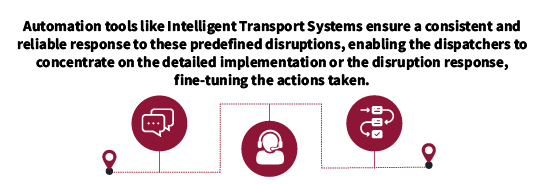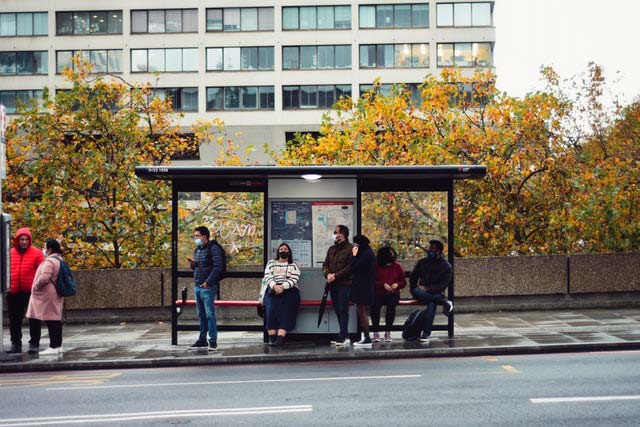Dealing with Public Transport Disruptions – How to Keep Your Passengers Moving
Find out how Intelligent Transport Systems can deal with public transport disruptions and diversions so that your passengers can keep moving to their destination.
It has been one of those days. The main bridge out of town has restrictions due to planned repairs; children laugh, and glasses clink as the main square is closed for the annual street party; and there is a car accident on the main shopping high street.
These events impact the public transport network, affecting passengers and their travel plans. The public transport response to these events must maintain operations, and at the same time, address the travelling public’s need for information. Information that enables them to answer the question, “what should I do?”
An effective response is only possible by managing these disruptions with the right Intelligent Transport Systems (ITS) tool. Pre-planning, monitoring operations in real-time, directing drivers and informing passengers are all inter-related ITS activities. Handled well, you can address the disruption and keep your passengers moving – a win-win situation, even on a difficult day.
Communicating Disruptions and Diversions
In today’s fast-paced and highly-connected environment, a passenger is fortunate to have several information sources available to them at any given moment. They want to minimise the impact of any disruption to their plans and may seek to build a picture of the possible and current situation – reviewing these various feeds and deciding what to do next.
The journey planner informs them of future possibilities and the wider strategic alternatives. But it is the real-time, current status websites and tools that provide information on the here and now. No matter which sources the passenger looks at, they should receive the same information.
Segal’s Law states: “A man with a watch knows what time it is. A man with two watches is never sure.”
Figure 1: Overview of the customer journey
Thus, when the dispatcher takes actions to resolve the disruption, they determine the vehicle actions, the diversion to take, the redirection, and the short turn. But these actions also need to automatically inform the passenger information subsystems, enabling a common representation of the dispatcher actions taken.
Planning for Failure
Because the bridgework in our scenario was known in advance, controllers may have a planned diversion for specific routes along alternative roads. Similarly, the main square closure activates a set of defined diversions to re-route buses and trams around the event. Planning for these events is important, but the planning must go further than just the start of the disruption.
Any diversions put in place may have an extended impact – for instance, the connection protection in the main square can no longer be met. Passengers need to be informed of this impact, as do the drivers. The roadside information signs at stops that are no longer being serviced need to be updated, in real-time, with details of services that are still stopping (if any), as well as services that are temporarily re-routed.
When services resume after the diversion has been removed, information needs to be further updated. Stop information needs to return to the originally planned operation, with all channels updated with a consistent message. This coordination needs to be organised to maintain consistent information, and technology tools are needed to assist and manage the situation.
Planned Disruptions
Most transport authorities define Standard Operating Procedures (SOPs) for foreseeable situations which define how to respond to them at various levels of detail. Obvious candidates are accidents, emergencies, and breakdowns. Some authorities define a range of responses to events, such as “when this happens …. do this, this and that”. Spending time preparing SOPs enables a consistent response to situations that can be implemented and coordinated. SOPs draw on experience so that they are rigorously developed, discussed, and approved. When a disruption happens, operators can activate this plan, steps are taken in the right order, and crucial actions are not missed. In the post-disruption calm, the plan can be reviewed and refined, continually improving the operators’ response.
Thus, if there is a critical bridge within the network, a SOP might be defined to divert several routes to other bridges, reducing the load, or even completely diverting all traffic. Corresponding timetable information could also be created to provide a robust set of information to passengers and drivers. Messages can be prepared for displays that convey the desired messages. The SOP is then implemented, and a pre-planned and coordinated response unfolds.
In many cases, the disruption is unlikely to be limited to one route. The critical bridge has many routes that use it. Therefore, the SOP automation will need to apply to all the routes impacted. The SOP can include a range of actions, such as planning the diversion itself, playing a defined announcement to impacted vehicles, and setting up a general message to be displayed on a range of information channels at different points on the network. These actions are planned in the SOP but executed by the system under the guidance of the dispatcher. As the network starts to recover, the same SOP action list can be used to remove the actions – either all at once, or controlled one by one by the dispatcher as the network returns to normal operations.

Unplanned Disruptions
The one-off accident in the shopping high street could not be planned, so dynamic responses might be needed. Spontaneous diversions should be set up and coordinated within the transport management system so that not only is the driver informed, but passengers are also automatically updated.
When setting up dynamic diversions, there are several factors that control room operators need to consider. These include: Can the bus, tram, or ferry travel along the intended diversion route? Does it avoid the actual disruption? Which stops are not served? What message should be displayed? And how does the driver know where to go?
The solution to many of these questions lies with the technology of the central control system. The diversion is planned graphically by dragging intermediate points to re-route the buses, trams, or ferries around the obstruction. The system will then use the underlying transport map to come up with a path to be followed.
As the system knows what kind of service is being diverted, it can consider the vehicle type. For instance, a tram needs to remain on tracks. An articulated bus may be unable to drive on all the available roads as its turning circle is restricted. A double-decker bus has height restrictions. A ferry cannot stop at a damaged pontoon. However, the automatic routing system considers all these restrictions when calculating the new path. If it is not possible to create the diversion the dispatcher desired, then this needs to be revised accordingly.
Then, with the diversion planned, it needs to be distributed to vehicles and followed. Here, the calculated route is sent to the vehicle and displayed, using SATNAV-like functionality to assist the driver to follow the diversion. Where the diversion intersects with stops, the system automatically adds this stop into the route network to display in the vehicle, as well as announcing arrivals on displays and mobile devices.

Conclusion
Running a public transport operation is never dull, with different challenges presented daily. The various demands for information and responses to disruptions need to be coordinated, and where possible, consistent in its approach.
Preparing standard responses to common situations ensures a level of response consistency and enables dispatchers to concentrate on the detail. Even when disruptions cannot be foreseen, the right tool helps operators implement an effective spontaneous diversion with associated passenger information.
Through rich, standardised interfaces to external systems, these disruption responses can be shared with the travelling public across their range of devices and information channels – keeping them informed of their options with consistent real-time information. This information enables passengers to reach their destination in the shortest time possible.
Trapeze provides ITS tools that have been proven through use in many public transport operations to enable the effective management of disruption response. These tools are continuously evolving and can be used to automatically deploy SOPs at the onset of disruption, during the disruption and in the aftermath as the network recovers. To find out how ITS technology can help you manage disruptions, contact us, and visit our ITS hub.
This article is Part 3 of a series on passenger information. See also:

